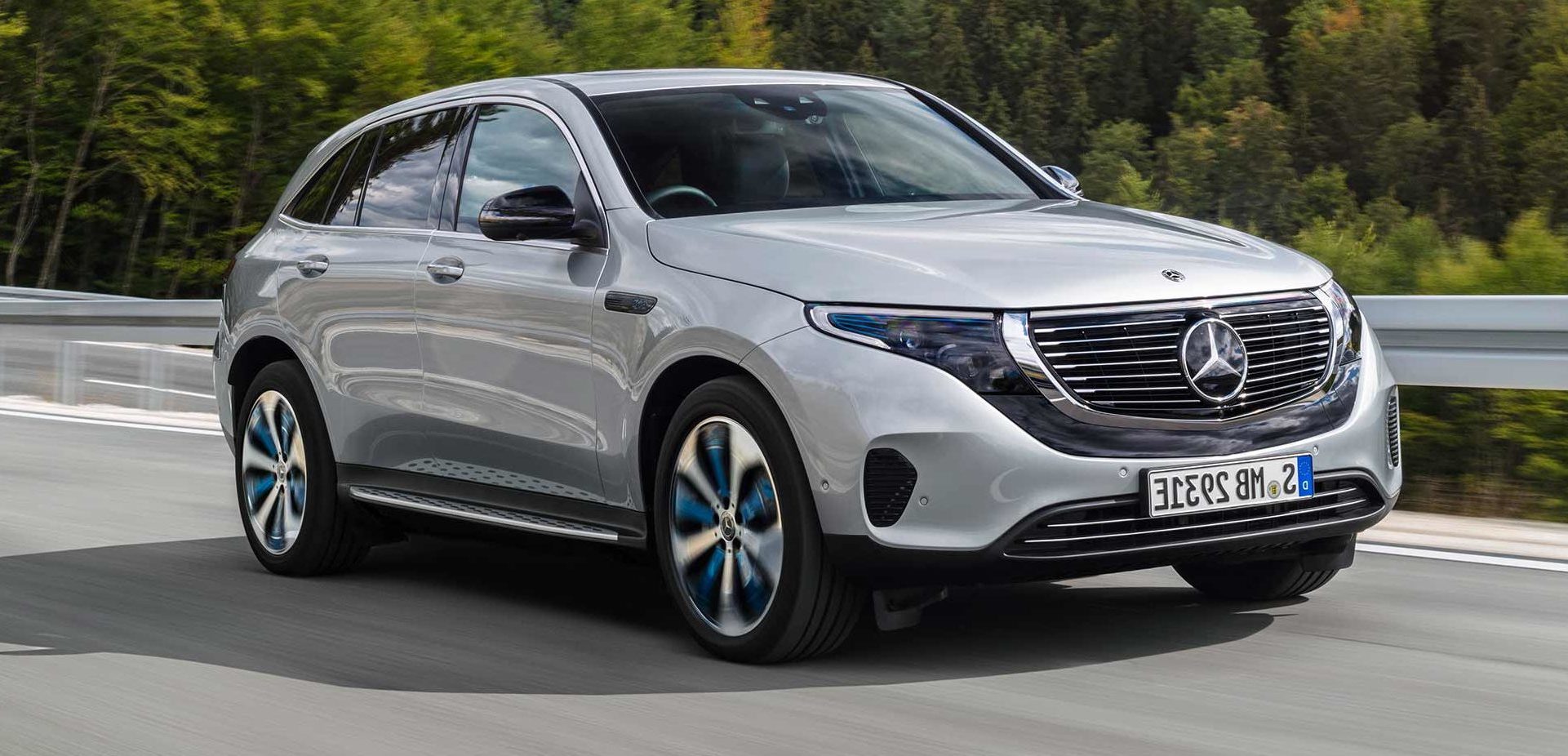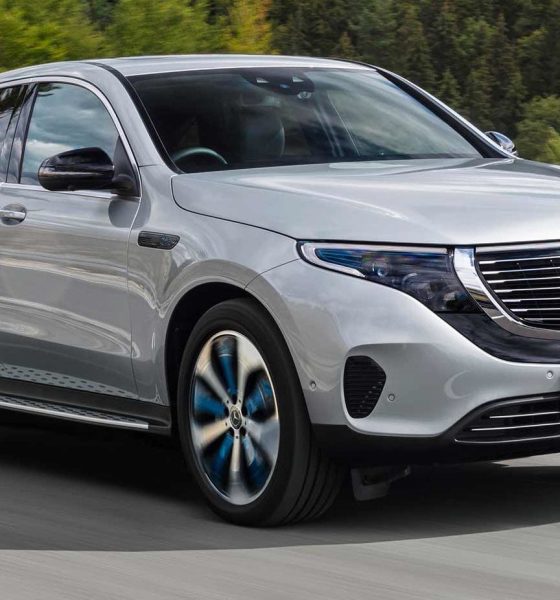

News
“Boring” EQC fails to provide Mercedes-Benz with EV momentum
The Mercedes-Benz EQC was supposed to be the German automaker’s answer to Tesla’s emergence as the dominant force in electric transportation. After an introduction that could only be described as a disappointment, Mercedes’ parent company Daimler’s Shareholder meeting on Wednesday revealed how some investors felt about the EQC’s underwhelming performance.
“Too late, too expensive, and too boring,” Speich said about the EQC, which has had less-than-desirable sales figures, according to the German Federal Motor Transport Authority.
In 2019, only 397 units of the EQC were sold, and as of May 28, 2020, an additional 276 have been sold. The combination of these two figures is indicative of less than 700 units sold since the vehicle’s launch in late 2019.
2019 was a rough year for Daimler, and the EQC undoubtedly contributed to the struggles the automaker felt over the previous twelve months. Deka Investment, which holds about 5.4 million shares of Daimler stock, was vocal when the EQC came to light during the Shareholder meeting.
The all-electric EQC was released last year, and Deka’s Head of Sustainability and Corporate Governance Ingo Speich had prepared remarks that broke down the disappointing performance of the car, Yahoo reported.
Not all is bad for Mercedes-Benz, though. The company’s deliveries in China climbed to a record in Q2 2020, and truck and global car sales rose in June compared to the same month in 2019. The company did state that it will not turn a profit in the quarter due to the coronavirus, which halted the automaker’s momentum that included a plan to implement “thousands” of efficiency measures, according to Daimler CEO Ola Kallenius.
“Our previous efficiency goals covered the upcoming transformation, but not a global recession,” Kallenius said. “Daimler can do better, and we are determined to deliver.”
Mercedes will unveil the compact EQA electric car later this year, Kallenius said. The luxury car company will also offer five electric models and more than 20 plug-in hybrids by the end of the year. The push toward electrification is geared toward meeting strict European emissions rules in 2020 and 2021. Kallenius stated that reaching the CO2 limits will be “challenging.”
Daimler shares have declined by 24% so far in 2020, giving the company a market cap of €40 billion, or $45.3 billion. This figure is less than 20% of Tesla’s $257.26 billion market cap.
Daimler also announced a restructuring plan in November that foresaw the elimination of more than 10,000 jobs worldwide. The move will save the company €1.4 billion, or $1.58 billion in personnel spending by 2022.
Although the EQC did not live up to the hype that Mercedes-Benz expected, there is still hope. With the German automaker planning to produce several more fully-electric models and a broad spectrum of hybrid vehicles in the future, the push toward a sustainable fleet is still within reason. Mercedes has a long history of manufacturing luxury automobiles, and shifting to electric transportation presents a variety of exciting challenges that have stumped some of the biggest car companies in the world, like Volkswagen.
There is room for improvement, but the EQC is not necessarily an indicator of what Mercedes-Benz has to offer. The company must learn from the underwhelming performance of the EQC and push for the development of more advanced EV technologies for its future models.

Elon Musk
Elon Musk and Tesla AI Director share insights after empty driver seat Robotaxi rides
The executives’ unoccupied tests hint at the rapid progress of Tesla’s unsupervised Robotaxi efforts.

Tesla CEO Elon Musk and AI Director Ashok Elluswamy celebrated Christmas Eve by sharing personal experiences with Robotaxi vehicles that had no safety monitor or occupant in the driver’s seat. Musk described the system’s “perfect driving” around Austin, while Elluswamy posted video from the back seat, calling it “an amazing experience.”
The executives’ unoccupied tests hint at the rapid progress of Tesla’s unsupervised Robotaxi efforts.
Elon and Ashok’s firsthand Robotaxi insights
Prior to Musk and the Tesla AI Director’s posts, sightings of unmanned Teslas navigating public roads were widely shared on social media. One such vehicle was spotted in Austin, Texas, which Elon Musk acknowleged by stating that “Testing is underway with no occupants in the car.”
Based on his Christmas Eve post, Musk seemed to have tested an unmanned Tesla himself. “A Tesla with no safety monitor in the car and me sitting in the passenger seat took me all around Austin on Sunday with perfect driving,” Musk wrote in his post.
Elluswamy responded with a 2-minute video showing himself in the rear of an unmanned Tesla. The video featured the vehicle’s empty front seats, as well as its smooth handling through real-world traffic. He captioned his video with the words, “It’s an amazing experience!”
Towards Unsupervised operations
During an xAI Hackathon earlier this month, Elon Musk mentioned that Tesla owed be removing Safety Monitors from its Robotaxis in Austin in just three weeks. “Unsupervised is pretty much solved at this point. So there will be Tesla Robotaxis operating in Austin with no one in them. Not even anyone in the passenger seat in about three weeks,” he said. Musk echoed similar estimates at the 2025 Annual Shareholder Meeting and the Q3 2025 earnings call.
Considering the insights that were posted Musk and Elluswamy, it does appear that Tesla is working hard towards operating its Robotaxis with no safety monitors. This is quite impressive considering that the service was launched just earlier this year.
Elon Musk
Starlink passes 9 million active customers just weeks after hitting 8 million
The milestone highlights the accelerating growth of Starlink, which has now been adding over 20,000 new users per day.

SpaceX’s Starlink satellite internet service has continued its rapid global expansion, surpassing 9 million active customers just weeks after crossing the 8 million mark.
The milestone highlights the accelerating growth of Starlink, which has now been adding over 20,000 new users per day.
9 million customers
In a post on X, SpaceX stated that Starlink now serves over 9 million active users across 155 countries, territories, and markets. The company reached 8 million customers in early November, meaning it added roughly 1 million subscribers in under seven weeks, or about 21,275 new users on average per day.
“Starlink is connecting more than 9M active customers with high-speed internet across 155 countries, territories, and many other markets,” Starlink wrote in a post on its official X account. SpaceX President Gwynne Shotwell also celebrated the milestone on X. “A huge thank you to all of our customers and congrats to the Starlink team for such an incredible product,” she wrote.
That growth rate reflects both rising demand for broadband in underserved regions and Starlink’s expanding satellite constellation, which now includes more than 9,000 low-Earth-orbit satellites designed to deliver high-speed, low-latency internet worldwide.
Starlink’s momentum
Starlink’s momentum has been building up. SpaceX reported 4.6 million Starlink customers in December 2024, followed by 7 million by August 2025, and 8 million customers in November. Independent data also suggests Starlink usage is rising sharply, with Cloudflare reporting that global web traffic from Starlink users more than doubled in 2025, as noted in an Insider report.
Starlink’s momentum is increasingly tied to SpaceX’s broader financial outlook. Elon Musk has said the satellite network is “by far” the company’s largest revenue driver, and reports suggest SpaceX may be positioning itself for an initial public offering as soon as next year, with valuations estimated as high as $1.5 trillion. Musk has also suggested in the past that Starlink could have its own IPO in the future.
News
NVIDIA Director of Robotics: Tesla FSD v14 is the first AI to pass the “Physical Turing Test”
After testing FSD v14, Fan stated that his experience with FSD felt magical at first, but it soon started to feel like a routine.

NVIDIA Director of Robotics Jim Fan has praised Tesla’s Full Self-Driving (Supervised) v14 as the first AI to pass what he described as a “Physical Turing Test.”
After testing FSD v14, Fan stated that his experience with FSD felt magical at first, but it soon started to feel like a routine. And just like smartphones today, removing it now would “actively hurt.”
Jim Fan’s hands-on FSD v14 impressions
Fan, a leading researcher in embodied AI who is currently solving Physical AI at NVIDIA and spearheading the company’s Project GR00T initiative, noted that he actually was late to the Tesla game. He was, however, one of the first to try out FSD v14.
“I was very late to own a Tesla but among the earliest to try out FSD v14. It’s perhaps the first time I experience an AI that passes the Physical Turing Test: after a long day at work, you press a button, lay back, and couldn’t tell if a neural net or a human drove you home,” Fan wrote in a post on X.
Fan added: “Despite knowing exactly how robot learning works, I still find it magical watching the steering wheel turn by itself. First it feels surreal, next it becomes routine. Then, like the smartphone, taking it away actively hurts. This is how humanity gets rewired and glued to god-like technologies.”
The Physical Turing Test
The original Turing Test was conceived by Alan Turing in 1950, and it was aimed at determining if a machine could exhibit behavior that is equivalent to or indistinguishable from a human. By focusing on text-based conversations, the original Turing Test set a high bar for natural language processing and machine learning.
This test has been passed by today’s large language models. However, the capability to converse in a humanlike manner is a completely different challenge from performing real-world problem-solving or physical interactions. Thus, Fan introduced the Physical Turing Test, which challenges AI systems to demonstrate intelligence through physical actions.
Based on Fan’s comments, Tesla has demonstrated these intelligent physical actions with FSD v14. Elon Musk agreed with the NVIDIA executive, stating in a post on X that with FSD v14, “you can sense the sentience maturing.” Musk also praised Tesla AI, calling it the best “real-world AI” today.








